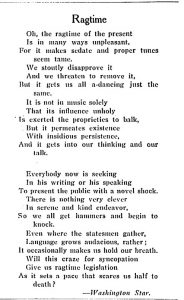Ragtime, from Scott Joplin to Jelly Roll Morton, has been deeply integral to America’s sense of musical identity. Also known as “jig piano” In the late 1800’s, black musicians would travel to bars and saloons to perform “ragged” versions of popular tunes. Although ragtime as a genre would not be formerly recognized until the very end of the 19th century, this was the true infancy of ragtime as a genre1. Ragtime existed under the radar of the general public as it was a mostly oral tradition that existed within the black community at the time, although white people were exposed to the genre as an accompaniment to minstrel shows2. It wasn’t until the 1893 World’s Fair in Chicago where ragtime started to garner attention from the white masses, with artists such as Joplin performing their rags to crowds who had likely never heard the genre before.
As white people became hip to the genre, white musicians began to imitate their black contemporaries and transcribed simplified versions of rag melodies for public purchase, and thus, “ragtime” as an established American genre was born. This isn’t to say that ragtime was completely beloved by the American public. Because of its iconic use of syncopation, and its origin as a form of Black American Music, ragtime was initially met with resistance from musical conservatives. Its detractors, who worshipped the canon of Western European classical music, saw ragtime as a scourge on the genre, lacking harmony for the sake of bizarre, chopped rhythm. This sentiment was shared by many white composers at the time. Leo Oehmler, a composer and violinist wrote in a periodical in a 1914 issue of the Musical Observer, “Let us take a united stand against the Ragtime Evil as we would against bad literature, and horrors of war or intemperance and other socially destructive evils. In Christian homes, where purity of morals is stressed, ragtime should find no resting place. Avaunt with ragtime rot! Let us purge America and the Divine Art of Music from this polluting nuisance”3.
https://www.youtube.com/watch?v=PYrlKGYUcBM
As shown in the somewhat tongue-in-cheek periodical at the top of this post, even those that were fans of ragtime saw it as a risqué genre, even it if was irresistible: “We stoutly disapprove it/ And we threaten to remove it/ But it gets us all a-dancing all the same” 4. White audiences saw ragtime music as a sort of forbidden fruit; an attitude that would extend to jazz and other forms of Black American Music throughout the 1900’s.
Citations
Star, Washington. 1913. “Ragtime.” Life (1883-1936), Jun 26, 1278. https://www.proquest.com/magazines/ragtime/docview/90727291/se-2.
Hatt, Nicholas Ryan. 2018. “A Portrait of Diversity: Exploring Underrepresented Violin Literature of the United States from 1893-1916.” Order No. 10784520, The Florida State University. https://www.proquest.com/dissertations-theses/portrait-diversity-exploring-underrepresented/docview/2102140606/se-2.
Harer, Ingeborg. “Defining Ragtime Music: Historical and Typological Research.” Studia Musicologica Academiae Scientiarum Hungaricae 38, no. 3/4 (1997): 409–15. https://doi.org/10.2307/902493.
2 Harer, Ingeborg. “Defining Ragtime Music: Historical and Typological Research.” Studia Musicologica Academiae Scientiarum Hungaricae 38, no. 3/4 (1997): 409–15. https://doi.org/10.2307/902493.
3 Hatt, Nicholas Ryan. 2018. “A Portrait of Diversity: Exploring Underrepresented Violin Literature of the United States from 1893-1916.” Order No. 10784520, The Florida State University. https://www.proquest.com/dissertations-theses/portrait-diversity-exploring-underrepresented/docview/2102140606/se-2.
4 Star, Washington. 1913. “Ragtime.” Life (1883-1936), Jun 26, 1278. https://www.proquest.com/magazines/ragtime/docview/90727291/se-2.


